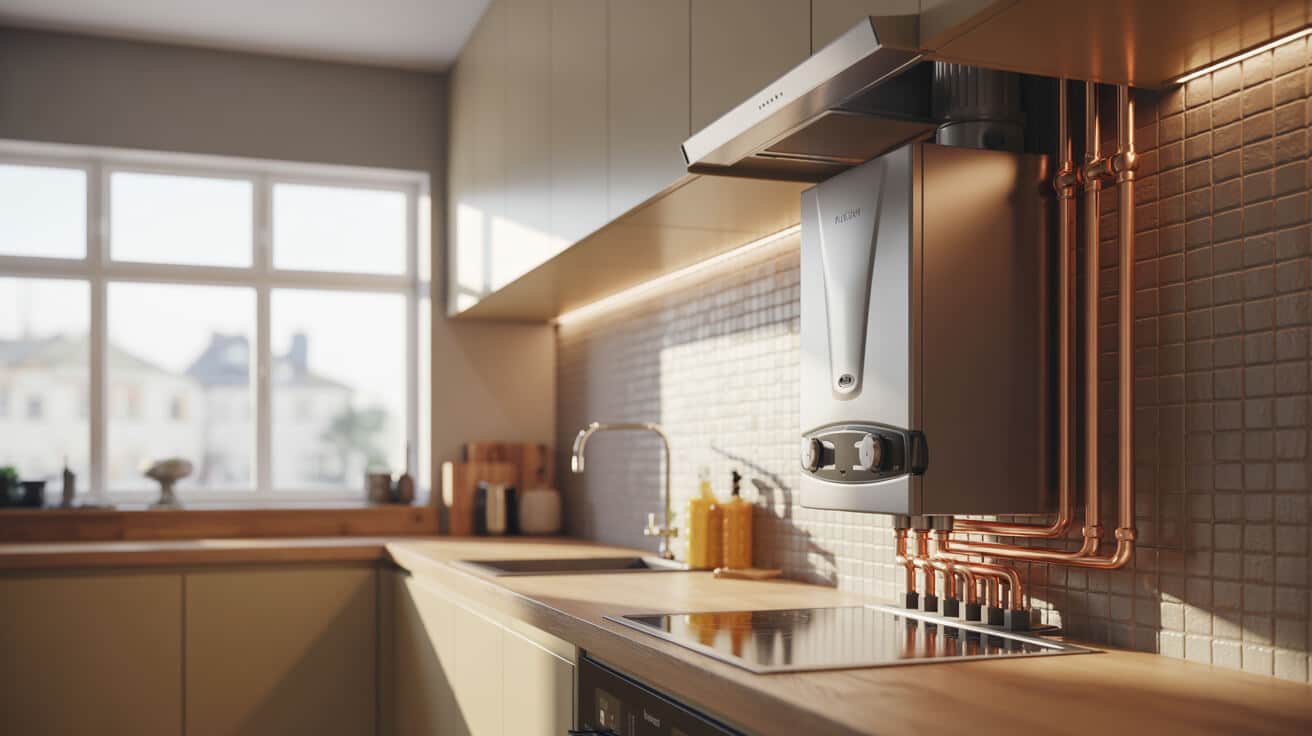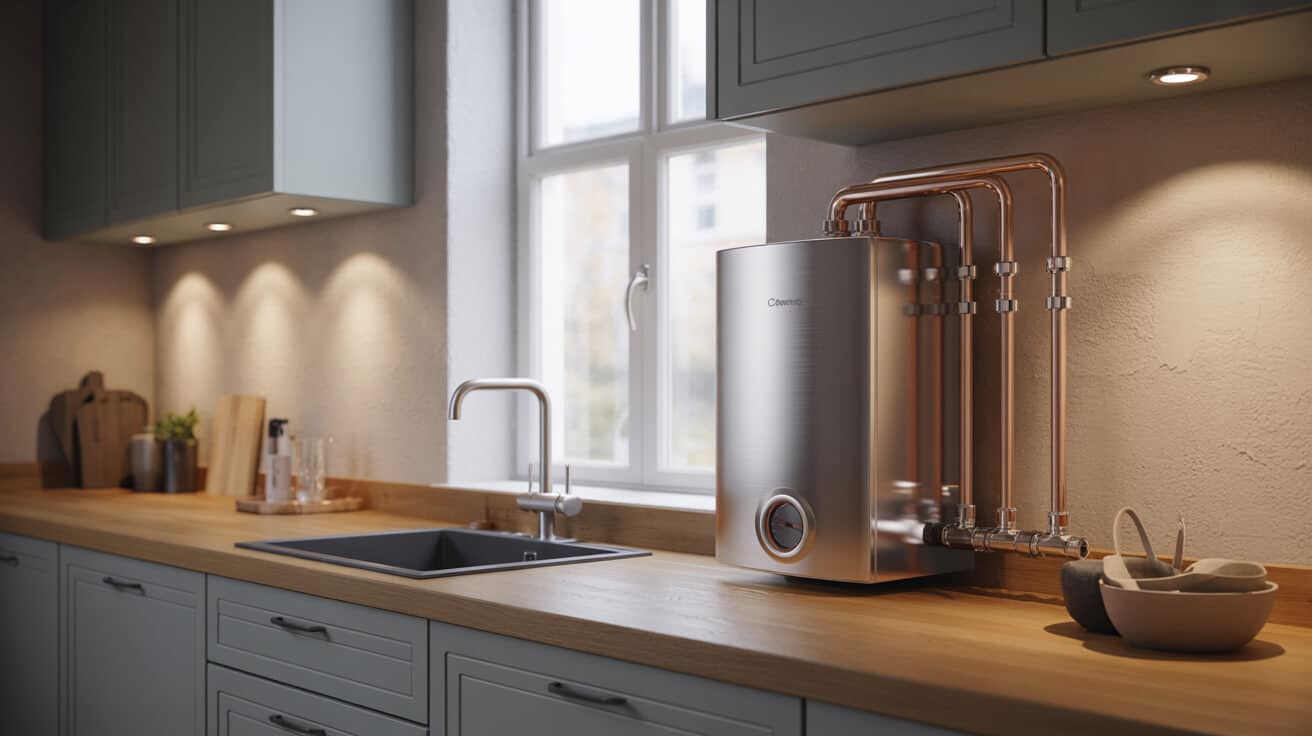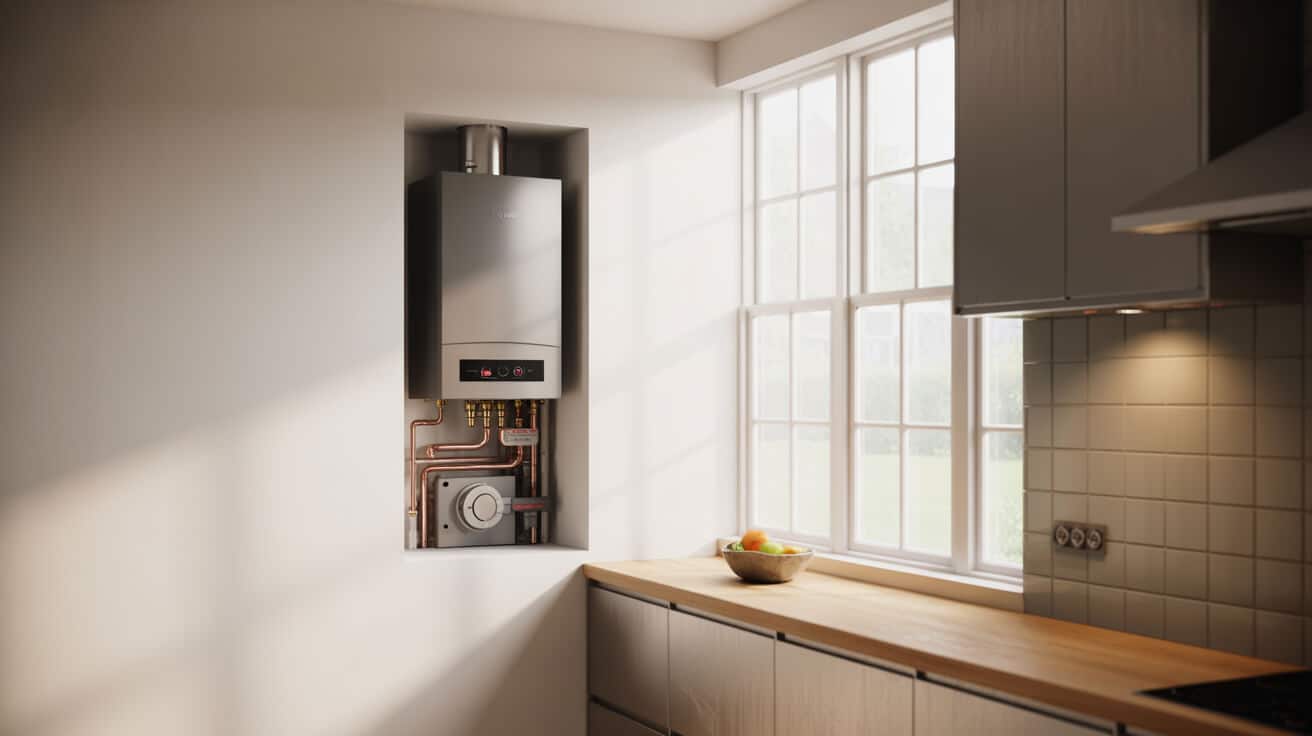Combi boiler installations combine the functions of central heating and water heating in a single, space-saving unit. This integration minimises heat loss by eliminating the need for separate hot water storage, while offering rapid responsiveness in providing hot water. Their design reflects advancements in energy efficiency technology and regulatory compliance, ensuring safe and reliable operation across varied building types.
Etymology or Name Origin
The term “combi boiler” is shorthand for “combination boiler,” which refers to the dual functionality of these systems — supplying both heating and hot water. The nomenclature originated as a means to differentiate these integrated systems from conventional boilers that require separate units. Over time, the evolution of combi boiler technology has underscored its alignment with the industry’s emphasis on efficiency and streamlined installation.
Overview / Context
Combi boilers represent a significant advancement in the field of plumbing and heating, particularly as modern design trends emphasise minimalism and energy conservation. They are engineered to operate without the need for a hot water storage tank, instead heating water directly from the mains when required. This not only reduces energy waste but also simplifies the installation process by utilising a single, compact unit. the adoption of combi boilers is especially prevalent in properties where space is at a premium and high-performance thermal systems are demanded.
Combi boiler installation typically involves a comprehensive assessment of a building’s existing infrastructure, including pipework evaluation and load analysis, to ensure that the unit is compatible with both heating and hot water demands. This context underscores the importance of adhering to UK building standards and regulatory requirements, which have evolved to address safety, energy efficiency, and environmental sustainability.
History
The evolution of combi boilers can be traced back to the need for more efficient heating systems during the energy crises of the late 20th century. Initially, domestic heating and hot water systems were installed as separate units, which often resulted in redundant energy loss. The advent of the combi boiler marked a turning point, integrating these functions into a singular system.
Origins and Early Designs
Early models of combi boilers were relatively simple in design and construction. They aimed primarily at providing on-demand hot water to address the inefficiencies in conventional water storage. Technological experimentation during this period laid the groundwork for increased efficiency and reliability.
Industrial Emergence
As the technology matured, manufacturers began to address the limitations of the initial designs. The integration of condensing technology allowed for a more efficient recovery of energy from the flue gases, thereby enhancing overall system efficiency. The emergence of digital controls and advanced safety mechanisms bolstered the combi boiler’s reputation as a safe option for both domestic and commercial markets.
Contemporary Evolution
Modern combi boilers incorporate sophisticated features such as smart thermostats, remote monitoring, and adaptive control systems. These advancements not only increase precision in temperature regulation and overall safety but also align with ongoing regulatory updates. Today’s systems are designed to meet stringent requirements for energy efficiency, significantly reducing carbon emissions and operational costs.

Concept / Description
A combi boiler is a self-contained unit designed to provide on-demand hot water and central heating simultaneously. Its operation is based on a direct heating method, where cold mains water is heated instantly as it passes through a high-efficiency heat exchanger.
Core Components
- Heat Exchanger: The component responsible for transferring heat from the combustion process to the water. It is typically made of high-performance materials to maximise thermal conductivity.
- Burner Assembly: Combusts fuel to generate the heat required for the system. Innovations in burner technology have resulted in lower emissions and enhanced fuel efficiency.
- Control Panel: An integrated interface that allows for the regulation of temperature, pressure, and system performance. This panel often includes a digital display and smart control features.
- Flue and Condensate System: Ensures the safe expulsion of exhaust gases and manages condensate disposal, in accordance with environmental safety standards.
- Safety Devices: Includes Temperature and Pressure Relief Valves (TPRV) and thermostatic mixing valves (TMV) that prevent system failures and safeguard against scalding.
Operational Principles
The unit is connected directly to the mains water supply, meaning that water is only heated when there is a demand. This on-demand process avoids the heat losses associated with maintaining large volumes of stored hot water. Control systems modulate the output based on real-time requirements, ensuring optimal performance during varying usage conditions.
Integration Features
Combi boilers are installed as an integral part of a building’s heating network. The design enables them to work in tandem with central heating systems and, increasingly, with smart thermostats and home automation systems, thereby offering enhanced operational efficiency and remote diagnostic capabilities.
Functionality / Purpose / Applications
Combi boilers serve the dual function of providing both household heating and instantaneous hot water without the need for a secondary storage tank. This self-contained design is particularly advantageous in environments where space is limited or where an energy-efficient solution is required.
Practical Applications
- Residential Installations: In homes, combi boilers offer immediate hot water and efficient space heating, making them ideal for apartments, terraced houses, and detached homes. Their compact design allows for installation in small utility spaces.
- Commercial Settings: For commercial properties or smaller office buildings, these boilers provide a reliable solution that minimises footprint while ensuring consistent hot water supply and heating across multiple zones.
- Retrofitting Projects: Older buildings undergoing renovations benefit from the integration of combi boilers, as they require less intrusive modifications to existing pipework and structures.
- Multi-zone Applications: In cases where properties have diverse heating requirements, combi boilers can be configured with smart controls to manage different zones, ensuring that energy is directed where it is most needed without waste.
Use Case Illustrations
- Energy Efficiency: By heating water on demand rather than storing it continuously, combi boilers contribute to lower energy consumption and reduced thermal losses.
- Space Optimization: The elimination of an external hot water tank reduces installation space and simplifies the layout of domestic and commercial heating systems.
- Cost Savings: Although the initial installation may be more complex, the resulting efficiency gains can lead to lower operational costs and reduced maintenance expenses over time.
Classifications / Types / Variants
Combi boilers are often distinguished by their operational characteristics, such as condensing versus non-condensing models, as well as by their integration capabilities.
Variants Based on Efficiency
- Condensing Combi Boilers: These units have an additional heat exchanger that recovers latent heat from exhaust gases, resulting in higher efficiency levels. They are favoured in regions with strict environmental regulations.
- Non-condensing Combi Boilers: While typically less efficient, these boilers may be chosen for their lower initial cost or in cases where condensing technology is not feasible due to installation constraints.
Variants Based on Control Systems
- Analogue Controls: Traditional models may use simpler, non-digital controls that require manual adjustments.
- Digital and Smart-Controlled Models: Modern units incorporate digital interfaces and connectivity features, allowing for remote monitoring, integrated smart thermostat operation, and adaptive learning based on usage patterns.
Classification by Application
- Domestic Units: Designed for homes, these models are often compact and optimised for single-dwelling efficiency.
- Commercial Units: Larger systems designed to handle the higher demand and multiple zones found in commercial properties.
- Multi-Functional Systems: Some models are engineered to integrate with renewable energy sources, such as solar thermal systems, further enhancing their efficiency and reducing operational costs.
Systems / Tools / Methodologies
The installation and commissioning of a combi boiler involve an array of specialised systems, tools, and established methodologies to ensure reliability and safety.
Installation Tools
- Pipe Cutting and Jointing Tools: Including pipe cutters, deburring tools, and PTFE tape, essential for a secure and leak-free pipework connection.
- Welding and Soldering Kits: Required for copper pipe installations, ensuring a durable bond between components.
- Pressure Testing Equipment: Such as test pumps and gauges used to verify that the system meets required pressure specifications.
- Leak Detection Devices: thermal imaging cameras and moisture metres assist in the early identification of installation issues.
Methodologies and Processes
- Site Survey and Load Calculations: A comprehensive assessment of a property’s current heating infrastructure and heat-loss measurements to determine the appropriate boiler capacity.
- System Design and Layout Planning: Involves creating detailed schematics for pipe routing, positioning isolation valves, and establishing expansion gaps. Proper planning is critical for ensuring that the installation runs efficiently and complies with regulatory standards.
- Installation Protocols: Step-by-step procedures covering initial preparation, mechanical fixings, gas and electrical connections, and integration with existing systems.
- Commissioning Procedures: A systematic set of tests performed post-installation, including pressure tests, flue gas analysis, safety device verification, and performance benchmarking.
- Maintenance Scheduling: Ongoing procedures for annual servicing, philtre cleaning, legibility checks, and regulatory compliance updates, ensuring the boiler continues to perform at its optimum level.

Stakeholders / Entities Involved
A successful combi boiler installation depends on the coordinated efforts of multiple stakeholders, each playing a defined role in the overall process.
Key Stakeholders
- Plumbing & Heating Companies: Organisations like Plumbers 4U that not only instal but also provide ongoing service and maintenance, ensuring adherence to industry best practices.
- Certified Installers: Technicians must be qualified with the appropriate certifications, such as Gas Safe, WRAS, and G3 for unvented systems, ensuring all work is conducted safely and competently.
- Regulatory Bodies: Authorities such as the Gas Safe Register, local building control agencies, and WRAS enforce standards and ensure compliance with safety regulations.
- End Users: Homeowners and landlords who rely on these systems for daily comfort, energy efficiency, and safety. Their satisfaction and feedback contribute significantly to future installation practices.
- Manufacturers: Companies that produce combi boilers and related components provide technical specifications and compliance documentation, vital for informed installation practices.
Collaborative Roles
Each of these groups works interdependently:
- The installers rely on manufacturer guidelines and certified tools.
- Regulatory bodies: establish the framework within which installation must occur.
- End users: ensure that performance metrics align with practical needs and expectations.
- Plumbing & Heating companies: coordinate these interactions to deliver a seamless, compliant service.
Legal / Regulatory / Ethical Considerations
Combi boiler installations in the United Kingdom are subject to a robust framework of legal, regulatory, and ethical standards designed to safeguard both users and installers.
Regulatory Framework
- Gas Safety Regulations: All installations must comply with Gas Safe Register requirements, ensuring that gas connections and appliances are installed correctly, with regular safety inspections.
- Building Regulations: Key areas include Part G (hot water safety), which sets out the appropriate measures for safe hot water systems, and Part L (energy efficiency), which drives improvements in thermal performance.
- WRAS and CP12 Certification: Combi boilers must meet the standards of the Water Regulations Advisory Scheme, guaranteeing compatibility with the mains water supply, and CP12 certification is required for gas safety, particularly in rental properties.
- G3 Certification: Required for unvented hot water systems, this certification ensures that installations adhere to stringent safety standards, minimising the risks of overpressurization and other hazards.
Ethical Considerations
- Transparency in Pricing: Providers must offer clear, itemised quotations that outline the scope of work without misleading the customer.
- Quality Assurance: Ethical installation practices include thorough documentation, quality checks, and a commitment to long-term system performance.
- Environmental Responsibility: With an increasing focus on reducing carbon footprints, installations must consider energy efficiency and the integration of renewable energy sources where feasible.
- Service Contracts and Guarantees: Effective communication about warranties, aftercare services, and maintenance plans builds trust and assures customers of ongoing support.
Performance Metrics / Data / Measurements
Evaluating combi boiler installations relies on a number of performance metrics that ensure both operational efficiency and safety are maintained throughout the system’s lifecycle.
Key Metrics
- Thermal Efficiency: Often measured by the percentage of fuel converted into usable heat, with condensing models achieving higher efficiency.
- System Pressure: Regular pressure testing is vital to confirm that the system operates within the recommended parameters. This includes both static and dynamic pressure assessments during commissioning.
- Safety Device Functionality: Verification of temperature and pressure relief valves (TPRV) and thermostatic mixing valves (TMV) is essential, as these components protect against overheating, overpressurization, and scalding.
- Commissioning Data: Metrics such as flue gas composition, pressure drops, and heat output readings are recorded during commissioning to calibrate the system.
- Maintenance Records: Data collected over time on service intervals, repair frequency, and changes in system performance help in assessing long-term reliability.
Measuring and Reporting
Performance data is typically recorded and monitored both during commissioning and as part of a regular maintenance schedule. This information is integrated into digital service logs to support predictive maintenance strategies and ongoing operational adjustments.
Challenges / Barriers / Limitations
Despite the efficiency and space-saving benefits, installing a combi boiler may pose a number of technical, economic, and regulatory challenges that require careful management.
Technical and Operational Issues
- System Integration: Achieving seamless integration between the combi boiler and existing heating networks can be difficult, particularly in retrofitting projects where older infrastructure is present.
- Pipework Constraints: Correctly routing and connecting new pipework to both the boiler and existing systems requires precision to avoid leaks and maintain system pressure.
- Pressure Variations: Ensuring that the system maintains consistent pressure, especially in larger or multi-zone installations, is vital for both performance and safety.
Economic and Regulatory Barriers
- Installation Costs: While combi boilers are efficient over the long term, their installation often requires a higher initial investment. This includes costs associated with specialised tools and expert labour.
- Compliance Requirements: Adhering to evolving regulatory standards, such as updates to building regulations and safety certifications, necessitates ongoing training and adaptation by installers.
- Maintenance Demands: The need for regular maintenance to ensure efficiency and safety can impose additional operational costs and scheduling challenges, particularly in rental or commercial properties.
Addressing Limitations
Technical training, continuing professional development, and adherence to standardised installation guidelines help mitigate many of these challenges. The balance between upfront costs and long-term energy savings is also a key consideration for each project.
Impact / Influence / Legacy
Combi boiler installations have transformed the plumbing and heating industry by offering a highly efficient and compact solution for space and energy management. Their influence extends across various dimensions of the industry.
Contributions to Energy Efficiency
- Reduced Heat Loss: By eliminating the need for a separate hot water storage tank, these systems minimise energy wastage, contributing to improved overall efficiency.
- Optimised Performance: Advanced digital controls and smart thermostats enable fine-tuning of performance settings, ensuring efficient energy use even during periods of intense demand.
Economic and Environmental Impact
- Cost Savings: The improved energy efficiency of combi boilers often translates into lower fuel consumption and reduced operational costs over time, benefiting both homeowners and commercial owners.
- Sustainability: Increased regulatory focus on emissions and energy use has driven the adoption of combi boilers as an environmentally responsible alternative to traditional systems.
Influence on Industry Practices
- Standardisation of Installation Procedures: The adoption of combi boilers has led to the establishment of rigorous installation protocols and quality assurance processes that elevate industry standards.
- Catalyst for Digital Integration: Modern combi boiler installations pave the way for further integration of smart technologies, enabling remote diagnostics and enhanced system management.
Future directions, cultural relevance, and design discourse
Emerging technological and regulatory trends suggest that combi boiler installations will undergo further evolution, driven by innovations in digital controls, renewable energy integration, and environmental sustainability.
Technological Forecast
Advances in sensor technology and smart control systems are poised to enable real-time monitoring of system performance, allowing for proactive maintenance and further optimization. Digital control interfaces are expected to become more intuitive, integrating seamlessly with building management systems to offer comprehensive oversight of heating and hot water usage.
Regulatory Evolution
As energy efficiency targets become increasingly stringent, regulatory bodies are likely to update standards to reflect cutting-edge technological capabilities. Future regulations may place additional emphasis on the integration of renewable energy sources, such as solar thermal technologies or air source heat pumps, with existing combi boiler configurations.
Cultural and Market Shifts
The evolution of combi boiler installations is also reflective of broader cultural trends towards sustainable living and minimalistic design. In urban environments where space is limited and energy costs are a significant concern, the compact and efficient nature of combi boilers will continue to drive their popularity. Moreover, the integration of digital monitoring and remote diagnostics aligns with a changing market that favours transparency, intelligent service delivery, and personalised user experiences.
Design Discourse
In the design arena, the fusion of traditional craftsmanship with modern digital tools is reshaping the narrative of combi boiler installations. There is a growing recognition of the need for a holistic approach that takes into account the entire lifecycle of heating systems—from initial installation through maintenance and eventual replacement. This paradigm shift is influencing training protocols, installation methodologies, and even the aesthetic design of future boiler units.
The legacy of combi boiler installations will be characterised by their contribution to energy conservation and building efficiency, as well as by their role in facilitating smarter, more responsive heating systems. As technology continues to advance, we can expect to see more adaptive systems that leverage artificial intelligence to predict maintenance needs and adjust system performance in real time.
In summary, the future landscape of combi boiler installations is set to be marked by increased integration of renewable technologies, enhanced digital control platforms, and a tighter coupling of performance metrics with regulatory compliance. This evolution is not only expected to improve functional outcomes but also to reinforce the environmental and economic benefits that have long made combi boilers an attractive option in the plumbing and heating industry.

